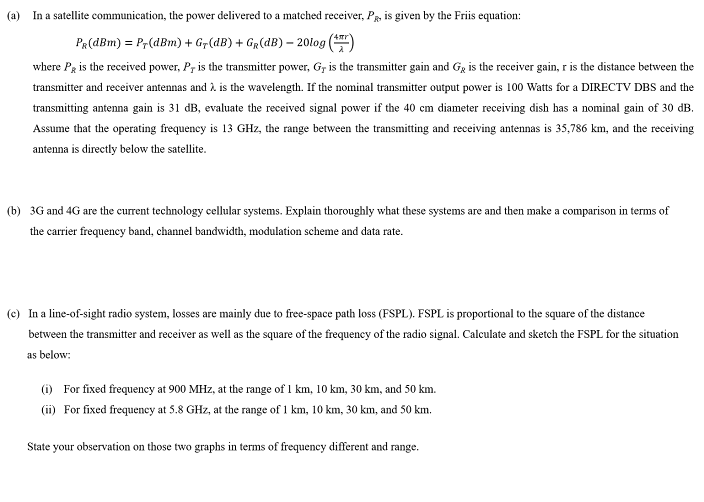(a) In a satellite communication, the power delivered to a matched receiver, P, is given by the Friis equation: PR(dBm) = Pr(dBm) + Gp(dB) + Gr(dB) – 20log where Pg is the received power, Pr is the transmitter power, Gy is the transmitter gain and Gg is the receiver gain, r is the distance between the transmitter and receiver antennas and . is the wavelength. If the nominal transmitter output power is 100 Watts for a DIRECTV DBS and the transmitting antenna gain is 31 dB, evaluate the received signal power if the 40 cm diameter receiving dish has a nominal gain of 30 dB. Assume that the operating frequeney is 13 GHz, the range between the transmitting and receiving antennas is 35,786 km, and the receiving antenna is directly below the satellite.
(a) In a satellite communication, the power delivered to a matched receiver, P, is given by the Friis equation: PR(dBm) = Pr(dBm) + Gp(dB) + Gr(dB) – 20log where Pg is the received power, Pr is the transmitter power, Gy is the transmitter gain and Gg is the receiver gain, r is the distance between the transmitter and receiver antennas and . is the wavelength. If the nominal transmitter output power is 100 Watts for a DIRECTV DBS and the transmitting antenna gain is 31 dB, evaluate the received signal power if the 40 cm diameter receiving dish has a nominal gain of 30 dB. Assume that the operating frequeney is 13 GHz, the range between the transmitting and receiving antennas is 35,786 km, and the receiving antenna is directly below the satellite.
Introductory Circuit Analysis (13th Edition)
13th Edition
ISBN:9780133923605
Author:Robert L. Boylestad
Publisher:Robert L. Boylestad
Chapter1: Introduction
Section: Chapter Questions
Problem 1P: Visit your local library (at school or home) and describe the extent to which it provides literature...
Related questions
Question
100%
Related to communication system

Transcribed Image Text:(a)
In a satellite communication, the power delivered to a matched receiver, PR, is given by the Friis equation:
PR(dBm) = Pr(dBm) + Gr(dB) + GR(dB) – 20log
where Pg is the received power, P, is the transmitter power, G, is the transmitter gain and Gg is the receiver gain, r is the distance between the
transmitter and receiver antennas and 2 is the wavelength. If the nominal transmitter output power is 100 Watts for a DIRECTV DBS and the
transmitting antenna gain is 31 dB, evaluate the received signal power if the 40 cm diameter receiving dish has a nominal gain of 30 dB.
Assume that the operating frequency is 13 GHz, the range between the transmitting and receiving antennas is 35,786 km, and the receiving
antenna is directly below the satellite.
(b) 3G and 4G are the current technology cellular systems. Explain thoroughly what these systems are and then make a comparison in terms of
the carrier frequency band, channel bandwidth, modulation scheme and data rate.
(c) In a line-of-sight radio system, losses are mainly due to free-space path loss (FSPL). FSPL is proportional to the square of the distance
between the transmitter and receiver as well as the square of the frequency of the radio signal. Calculate and sketch the FSPL for the situation
as below:
(i) For fixed frequency at 900 MHz, at the range of 1 km, 10 km, 30 km, and 50 km.
(ii) For fixed frequency at 5.8 GHz, at the range of 1 km, 10 km, 30 km, and 50 km.
State your observation on those two graphs in terms of frequency different and range.
Expert Solution
This question has been solved!
Explore an expertly crafted, step-by-step solution for a thorough understanding of key concepts.
Step by step
Solved in 2 steps

Knowledge Booster
Learn more about
Need a deep-dive on the concept behind this application? Look no further. Learn more about this topic, electrical-engineering and related others by exploring similar questions and additional content below.Recommended textbooks for you

Introductory Circuit Analysis (13th Edition)
Electrical Engineering
ISBN:
9780133923605
Author:
Robert L. Boylestad
Publisher:
PEARSON

Delmar's Standard Textbook Of Electricity
Electrical Engineering
ISBN:
9781337900348
Author:
Stephen L. Herman
Publisher:
Cengage Learning

Programmable Logic Controllers
Electrical Engineering
ISBN:
9780073373843
Author:
Frank D. Petruzella
Publisher:
McGraw-Hill Education

Introductory Circuit Analysis (13th Edition)
Electrical Engineering
ISBN:
9780133923605
Author:
Robert L. Boylestad
Publisher:
PEARSON

Delmar's Standard Textbook Of Electricity
Electrical Engineering
ISBN:
9781337900348
Author:
Stephen L. Herman
Publisher:
Cengage Learning

Programmable Logic Controllers
Electrical Engineering
ISBN:
9780073373843
Author:
Frank D. Petruzella
Publisher:
McGraw-Hill Education

Fundamentals of Electric Circuits
Electrical Engineering
ISBN:
9780078028229
Author:
Charles K Alexander, Matthew Sadiku
Publisher:
McGraw-Hill Education

Electric Circuits. (11th Edition)
Electrical Engineering
ISBN:
9780134746968
Author:
James W. Nilsson, Susan Riedel
Publisher:
PEARSON

Engineering Electromagnetics
Electrical Engineering
ISBN:
9780078028151
Author:
Hayt, William H. (william Hart), Jr, BUCK, John A.
Publisher:
Mcgraw-hill Education,